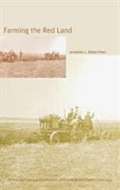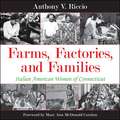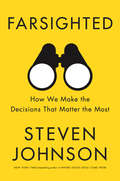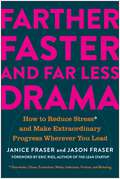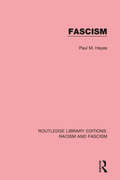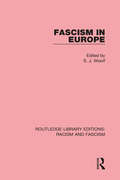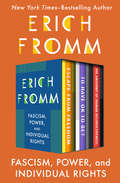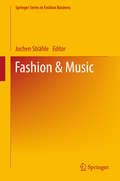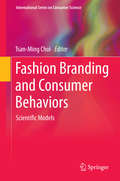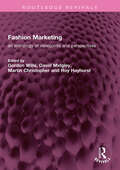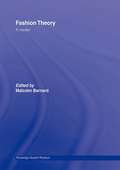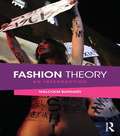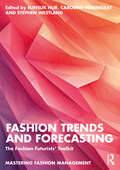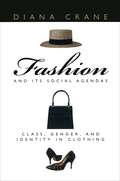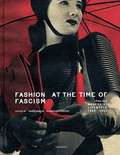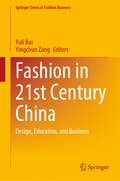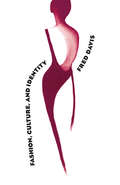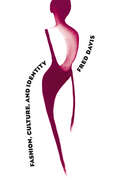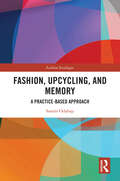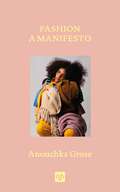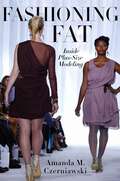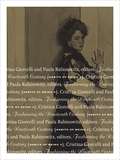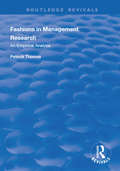- Table View
- List View
Farming the Red Land: Jewish Agricultural Colonization and Local Soviet Power, 1924-1941
by Jonathan L. Dekel-ChenThis is the first history of the Jewish agricultural colonies that were established in Crimea and Southern Ukraine in 1924 and that, fewer than 20 years later, ended in tragedy. Jonathan Dekel-Chen opens an extraordinary window on Soviet rural life during these turbulent years, and he documents the remarkable relations that developed among the American-Jewish sponsors of the ambitious project, the Soviet authorities, and the colonists themselves. Drawing on extensive and largely untouched archives and a wealth of previously unpublished oral histories, the book revises what has been understood about these agricultural settlements. Dekel-Chen offers new conclusions about integration and separation among Soviet Jews, the contours of international relations, and the balance of political forces within the Jewish world during this volatile period.
Farms, Factories, and Families: Italian American Women of Connecticut
by Anthony V. Riccio Mary Ann McDonald CarolanDocuments the rich history of Italian American working women in Connecticut, including the crucial role they played in union organizing.
Farsighted: How We Make the Decisions That Matter the Most
by Steven JohnsonThe hardest choices are also the most consequential. So why do we know so little about how to get them right? Big, life-altering decisions matter so much more than the decisions we make every day, and they're also the most difficult: where to live, whom to marry, what to believe, whether to start a company, how to end a war. There's no one-size-fits-all approach for addressing these kinds of conundrums. Steven Johnson's classic Where Good Ideas Come From inspired creative people all over the world with new ways of thinking about innovation. In Farsighted, he uncovers powerful tools for honing the important skill of complex decision-making. While you can't model a once-in-a-lifetime choice, you can model the deliberative tactics of expert decision-makers. These experts aren't just the master strategists running major companies or negotiating high-level diplomacy. They're the novelists who draw out the complexity of their characters' inner lives, the city officials who secure long-term water supplies, and the scientists who reckon with future challenges most of us haven't even imagined. The smartest decision-makers don't go with their guts. Their success relies on having a future-oriented approach and the ability to consider all their options in a creative, productive way. Through compelling stories that reveal surprising insights, Johnson explains how we can most effectively approach the choices that can chart the course of a life, an organization, or a civilization. Farsighted will help you imagine your possible futures and appreciate the subtle intelligence of the choices that shaped our broader social history.
Farther, Faster, and Far Less Drama: How to Reduce Stress and Make Extraordinary Progress Wherever You Lead
by Janice Fraser Jason FraserFarther, Faster, and Far Less Drama offers a simple but powerful set of leadership behaviors to align teams and accelerate progress. Fom team leaders to consultants to stay-at-home parents, everyone wishes life could be less complex, but that often feels impossible. Janice and Jason Fraser introduce the Four Leadership Motions, a method they have been using for decades to help all kinds of teams make fast, meaningful progress—including Navy SEALs, startup CEOs, and Fortune 100 executives. With the Four Leadership Motions, you will set and achieve goals faster, make complex situations more manageable, and create momentum even during overwhelming circumstances. The book calls on readers to: Orient honestly to understand the complexities of any situation Value outcomes more than plans, activities, or deliverables Leverage the brains by tapping the right people and maximizing their contribution Make durable decisions by eliminating the two pernicious kinds of waste Farther, Faster, and Far Less Drama offers theory alongside hands-on exercises, formulas, and frameworks that can all be adapted to real-life situations in both professional and personal contexts. The world around you might constantly be in flux, but you don&’t have to be. With this book, you&’ll be empowered to make efficient progress with less stress—every single day.
Fascism (Routledge Library Editions: Racism and Fascism)
by Paul M. HayesThis book, first published in 1973, sets out to clear away many of the confused ideas and misconceptions concerning the origins and nature of fascism. The first section deals with the intellectual origins of fascism and examines the constituent strands and development of fascist theory, including discussion of such topics as the myth of race, the idea of the elite and the leader, nationalism, and the influence of militarism. The book then goes on to look at fascism in action, particularly in relation to economic affairs. The author here examines the process by which the fascists came to power in Germany and Italy, investigating both the political and social causes. A third section contains discussion of the nature of more recent regimes in Greece, Latin America and Africa.
Fascism in Europe (Routledge Library Editions: Racism and Fascism)
by S. J. WoolfWhat was fascism, why did it gain support between the wars, and could it happen again? This collection of essays, published in 1981, by leading authorities on the subject, offers a comprehensive study of European fascism, with a detailed analysis of its roots, its extraordinary strength between the two world wars, and its prospects in modern Europe. The essays discuss the economic, political and social conditions out of which individual fascist movements arose, the crucial problem of why a few fascist parties succeeded but most failed. The essays on Italy, Germany and Spain examine the continuities and contradictions between the fascist movements in opposition and the fascist regimes in power. The introductory and conclusive essays are concerned with the overall problem of the historical nature of the fascist phenomenon, but all the papers address themselves directly to this theme, testing the generalizations made by social scientists against the historical experiences of individual countries. Besides Italy and Germany, which harboured the major fascist movements, the countries discussed range from those with traditional parliamentary democracies – such as England, France, Belgium and Norway – to the new states which emerged from the collapse of the central European empires, such as Austria, Hungary, Romania and Poland. Originally published in 1968 under the title European Fascism, this survey acquired a worldwide reputation for its excellent and wide-ranging account of the history, role and functions of fascism in Europe. The present edition contains six new or wholly re-written essays and three substantially revised ones.
Fascism, Power, and Individual Rights: Escape from Freedom, To Have or To Be?, and The Anatomy of Human Destructiveness
by Erich FrommThree fascinating examinations of the psychology of political power from the New York Times–bestselling author of The Art of Loving. Philosopher and social theorist Erich Fromm is renowned as “a psychologist of penetration and a writer of ability” (Chicago Tribune). In these three riveting works, Fromm sheds light on some of the most critical dilemmas facing humanity. Escape from Freedom: Though freedom has been a prized value in Western culture for centuries, it is often accompanied by feelings of anxiety and powerlessness. Fromm’s compelling study demonstrates how these feelings of alienation can lead to a desire for conformity and authoritarianism, bringing invaluable insight into the rise of Nazism and fascism in Europe. To Have or To Be?: Life in the modern age began when people no longer lived at the mercy of nature and instead took control of it. Fromm argues that through the process of modern materialism, the natural tendency of humankind moved away from practicing human abilities, and instead focused on possessing objects. Humankind therefore began using tools that replace our own powers to think, feel, and act independently. Fromm argues that positive change—both social and economic—will come from being, loving, and sharing. The Anatomy of Human Destructiveness: This classic study makes a distinction between animal aggression and certain forms of destructiveness that can only be found in human beings. His case studies span zoo animals, necrophiliacs, and the psychobiographies of notorious figures such as Hitler and Stalin, offering a comprehensive exploration of the human impulse for violence. This ebook features an illustrated biography of Erich Fromm including rare images and never-before-seen documents from the author’s estate.
Fashion & Music
by Jochen SträhleThis book will broaden readers’ understanding of the links between the music and fashion industries. It highlights the challenges currently facing the fashion industry in terms of hyper-competition, definition of ever-faster trends, changing consumer demands etc. In fact, the fashion industry is heavily influenced by the digital revolution in the music industry, which has changed the face of individual music consumption and social reference, and therefore, also has impacts on fashion consumption and social reference. This understanding is crucial in order to realign any fashion company’s strategies to the demands of modern fashion consumers. In terms of content, the book first discusses the social perspective of fashion and music. This includes an analysis of music as a key influencer of fashion trends, both theoretically and on the basis of a case study on grunge music. Then the role of music in the fashion business is addressed, and covers in-store music and the role of music in fashion communication. Following up, the role of fashion in the music business is analyzed. This includes the trend of co-design of fashion collections, music artists’ role of differentiation by style, and the market for music fashion merchandise articles (both theoretically and drawing on a case study). In closing, potential lessons learned from the music industry are developed for the fashion industry. This includes an analysis of the digital revolution and the advent of the crowdfunding idea (both theoretically and in a case study).
Fashion Branding and Consumer Behaviors
by Tsan-Ming ChoiFashion Branding and Consumer Behaviors presents eye-opening theory, literature review and original research on the mutual influence of branding strategies and consumer response. Contributors use multiple methods to analyze consumers' psychosocial needs and the extent that their fulfillment goes beyond the usefulness or value of the items they purchase as well as the fashion industry's means of communicating brand identity and enhancing brand loyalty. Along the way, these studies raise important questions about consumer behaviors, consumer welfare, environmental ethics and the future of consumer research. Included in the coverage: A symbolic interactionist perspective on fashion brand personality and advertisement response. Optimizing fashion branding strategies in a fluctuating market. An analysis of fashion brand extensions by artificial neural networks. Domestic or foreign luxury brands? A comparison of status- and non-status- seeking teenagers. The impact of consumers' need for uniqueness on purchase perception. How brand awareness relates to market outcome, brand equity and the marketing mix. A breakthrough volume on the complexities of how and why we buy, Fashion Branding and Consumer Behaviors will captivate researchers and practitioners in the fields of consumer psychology, marketing and economics.
Fashion Marketing: an anthology of viewpoints and perspectives (Routledge Revivals)
by Martin Christopher David Midgley Roy Hayhurst Gordon WillsFirst published in 1973, Fashion Marketing is intended for all whose work is linked to the vagaries of fashion or who are simply fascinated by the subject. Although much of the evidence and material collected here is related to textiles and clothing in particular, businessmen are becoming increasingly aware that fashion now extends its influence beyond its traditional fields. The fickleness of fashion has previously discouraged detailed analysis of trends, and such significant contributions to the literature as have been made often occur in the most unlikely places. It was this inaccessibility which led to the preparation of the present volume, which developed out of the considerable research activity into textile markets by the editors, first at the University of Bradford, and more recently at the Cranfield School of Management to which their research work was transferred in 1972. This book will be of interest to students of business, economics, marketing and fashion.
Fashion Theory: A Reader (Routledge Student Readers)
by Malcolm BarnardFrom its beginnings in the fifteenth century, intensified interest in fashion and the study of fashion over the last thirty years has led to a vast and varied literature on the subject. This collection of essays surveys and contextualizes the ways in which a wide range of disciplines have used a variety of theoretical approaches to explain, and sometimes to explain away, the astonishing variety, complexity and beauty of fashion. Themes covered include individual, social and gender identity, the erotic, consumption and communication. By collecting together some of the most influential and important writers on fashion and exposing the ideas and theories behind what they say, this unique collection of extracts and essays brings to light the presuppositions involved in the things we think and say about fashion.
Fashion Theory: A Reader (Routledge Student Readers)
by Malcolm BarnardThis thoroughly revised and updated edition of Fashion Theory: A Reader brings together and presents a wide range of essays on fashion theory that will engage and inform both the general reader and the specialist student of fashion. From apparently simple and accessible theories concerning what fashion is to seemingly more difficult or challenging theories concerning globalisation and new media, this collection contextualises different theoretical approaches to identify, analyse and explain the remarkable diversity, complexity and beauty of what we understand and experience every day as fashion and clothing. This second edition contains entirely new sections on fashion and sustainability, fashion and globalisation, fashion and digital/social media and fashion and the body/prosthesis. It also contains updated and revised sections on fashion, identity and difference, and on fashion and consumption and fashion as communication. More specifically, the section on identity and difference has been updated to include contemporary theoretical debates surrounding Islam and fashion, and LGBT+ communities and fashion and the section on consumption now includes theories of 'prosumption'. Each section has a specialist and dedicated Editor's Introduction which provides essential conceptual background, theoretical contextualisation and critical summaries of the readings in each section. Bringing together the most influential and ground breaking writers on fashion and exposing the ideas and theories behind what they say, this unique collection of extracts and essays brings to light the presuppositions involved in the things we all think and say about fashion. This second edition of Fashion Theory: A Reader is a timeless and invaluable resource for both the general reader and undergraduate students across a range of disciplines including sociology, cultural studies and fashion studies.
Fashion Theory: An Introduction (Routledge Student Readers Ser.)
by Malcolm BarnardFashion is both big business and big news. From models’ eating disorders and sweated labour to the glamour of a new season's trends, statements and arguments about fashion and the fashion industry can be found in every newspaper, consumer website and fashion blog. Books which define, analyse and explain the nature, production and consumption of fashion in terms of one theory or another abound. But what are the theories that run through all of these analyses, and how can they help us to understand fashion and clothing? Fashion Theory: an introduction explains some of the most influential and important theories on fashion: it brings to light the presuppositions involved in the things we think and say about fashion every day and shows how they depend on those theories. This clear, accessible introduction contextualises and critiques the ways in which a wide range of disciplines have used different theoretical approaches to explain – and sometimes to explain away – the astonishing variety, complexity and beauty of fashion. Through engaging examples and case studies, this book explores: fashion and clothing in history fashion and clothing as communication fashion as identity fashion, clothing and the body production and consumption fashion, globalization and colonialism fashion, fetish and the erotic. This book will be an invaluable resource for students of cultural studies, sociology, gender studies, fashion design, textiles or the advertising, marketing and manufacturing of clothes.
Fashion Trends and Forecasting: The Fashion Futurists' Toolkit (Mastering Fashion Management)
by Stephen Westland Caroline HemingrayFashion Trends and Forecasting explores how designers, merchandisers, buyers, marketers and strategists use fashion trend forecasting to predict upcoming trends and understand past or current ones.It explains the importance of trend forecasting for businesses and how technology such as artificial intelligence can help to advance it for the future. Addressing both macro- and micro-trends, including fashion styles, textiles and colour trends as well as the impact of technology such as AI and the metaverse, the book offers guidance on how fashion students can address fast-changing consumer needs and demands and identify wider shifts in the cultural, environmental, political and technological worlds. Case studies from globally recognised organisations feature in every chapter, highlighting and contextualising theory for students. Discussion questions, further reading and exercises help facilitate class discussion and deeper understanding.Designed to equip the reader with Fashion Forecasting tools, methods and principles in an accessible and clear way, this text is recommended and core reading for students studying fashion forecasting, fashion buying and fashion marketing.Supplementary online resources can be found at www.routledge.com/9781032541860 and include a short instructor’s manual of points to be used for seminar discussions and chapter-by-chapter PowerPoint slides for instructors.
Fashion and Its Social Agendas: Class, Gender, and Identity in Clothing
by Diana CraneIt has long been said that clothes make the man (or woman), but is it still true today? If so, how has the information clothes convey changed over the years? Using a wide range of historical and contemporary materials, Diana Crane demonstrates how the social significance of clothing has been transformed. Crane compares nineteenth-century societies—France and the United States—where social class was the most salient aspect of social identity signified in clothing with late twentieth-century America, where lifestyle, gender, sexual orientation, age, and ethnicity are more meaningful to individuals in constructing their wardrobes. Today, clothes worn at work signify social class, but leisure clothes convey meanings ranging from trite to political. In today's multicode societies, clothes inhibit as well as facilitate communication between highly fragmented social groups. Crane extends her comparison by showing how nineteenth-century French designers created fashions that suited lifestyles of Paris elites but that were also widely adopted outside France. By contrast, today's designers operate in a global marketplace, shaped by television, film, and popular music. No longer confined to elites, trendsetters are drawn from many social groups, and most trends have short trajectories. To assess the impact of fashion on women, Crane uses voices of college-aged and middle-aged women who took part in focus groups. These discussions yield fascinating information about women's perceptions of female identity and sexuality in the fashion industry. An absorbing work, Fashion and Its Social Agendas stands out as a critical study of gender, fashion, and consumer culture. "Why do people dress the way they do? How does clothing contribute to a person's identity as a man or woman, as a white-collar professional or blue-collar worker, as a preppie, yuppie, or nerd? How is it that dress no longer denotes social class so much as lifestyle? . . . Intelligent and informative, [this] book proposes thoughtful answers to some of these questions."-Library Journal
Fashion and its Social Agendas
by Diana CraneIt has long been said that clothes make the man (or woman), but is it still true today? If so, how has the information clothes convey changed over the years? Using a wide range of historical and contemporary materials, Diana Crane demonstrates how the social significance of clothing has been transformed. Crane compares nineteenth-century societies—France and the United States—where social class was the most salient aspect of social identity signified in clothing with late twentieth-century America, where lifestyle, gender, sexual orientation, age, and ethnicity are more meaningful to individuals in constructing their wardrobes. Today, clothes worn at work signify social class, but leisure clothes convey meanings ranging from trite to political. In today's multicode societies, clothes inhibit as well as facilitate communication between highly fragmented social groups. Crane extends her comparison by showing how nineteenth-century French designers created fashions that suited lifestyles of Paris elites but that were also widely adopted outside France. By contrast, today's designers operate in a global marketplace, shaped by television, film, and popular music. No longer confined to elites, trendsetters are drawn from many social groups, and most trends have short trajectories. To assess the impact of fashion on women, Crane uses voices of college-aged and middle-aged women who took part in focus groups. These discussions yield fascinating information about women's perceptions of female identity and sexuality in the fashion industry. An absorbing work, Fashion and Its Social Agendas stands out as a critical study of gender, fashion, and consumer culture. "Why do people dress the way they do? How does clothing contribute to a person's identity as a man or woman, as a white-collar professional or blue-collar worker, as a preppie, yuppie, or nerd? How is it that dress no longer denotes social class so much as lifestyle? . . . Intelligent and informative, [this] book proposes thoughtful answers to some of these questions. "-Library Journal
Fashion at the Time of Fascism: Italian Modernist Lifestyle Between, 1922-1943
by Mario Lupano Alessandra VaccariThe first visual history of Modernist Italian fashion during Benito Mussolini's Fascist regime, and the product of immense research, Fashion at the Time of Fascism charts the fashion industry's ambivalent negotiation of international couture and the bizarre dictates of Fascism, and the legacy of this era in shaping today's fashion industry. Authors Mario Lupano and Alessandra Vaccari explore and compare a huge range of forgotten archival sources, such as women's glossies, fashion, film and gossip magazines, photo archives, exhibition and commercial catalogues, books, manuals and magazines on tailoring, dressmaking, design and architecture, and corporate and government journals. This abundance of materials is presented in a fluid sequence of image and text that charts the rhythms, rituals and lifestyles of the typical Italian day through the four basic themes of "Measurements," "Model," "Brand" and "Parade." Each section includes texts that highlight the key figures and phases in Italian fashion, from the 1920s to the early 1940s, juxtaposing them with Modernism's broader salient themes and emphasizing the conscious use of glamour in the regime's super-choreographed portrayal of itself. Fashion at the Time of Fascism is further enriched by a thorough iconographic index and a detailed reference list, making the volume a revelation for both general readers and scholars.
Fashion in 21st Century China: Design, Education, and Business (Springer Series in Fashion Business)
by Yuli Bai Yingchun ZangThis book explores the dynamic landscape of fashion in China since the beginning of the 21st century through an integrated perspective. The book considers key questions related to the changes in China’s fashion dynamics driven largely by the shifts in the mindset of Chinese consumers due to the current sociocultural contexts. To provide an understanding of these important shifts, this three-part monograph pays close attention to the new generation of Chinese fashion designers and consumers. The book explores in detail related topics such as, how today’s Chinese consumers relate to foreign brands, the meaning of apparel brands as identity symbols or cultural signs to contemporary young consumers, the attractiveness of Western fashion designers and brands in the eyes of current Chinese consumers as compared to past consumers, and how brands could adapt to the online-centered consumption behavior. The book serves as an insightful update on the Chinese fashion landscape for researchers, practitioners and passionate followers of its evolution.
Fashion, Culture, and Identity (Emersion: Emergent Village Resources For Communities Of Faith Ser.)
by Fred DavisWhat do our clothes say about who we are or who we think we are? How does the way we dress communicate messages about our identity? Is the desire to be "in fashion" universal, or is it unique to Western culture? How do fashions change? These are just a few of the intriguing questions Fred Davis sets out to answer in this provocative look at what we do with our clothes—and what they can do to us. Much of what we assume to be individual preference, Davis shows, really reflects deeper social and cultural forces. Ours is an ambivalent social world, characterized by tensions over gender roles, social status, and the expression of sexuality. Predicting what people will wear becomes a risky gamble when the link between private self and public persona can be so unstable.
Fashion, Culture, and Identity (Emersion: Emergent Village Resources For Communities Of Faith Ser.)
by Fred DavisWhat do our clothes say about who we are or who we think we are? How does the way we dress communicate messages about our identity? Is the desire to be "in fashion" universal, or is it unique to Western culture? How do fashions change? These are just a few of the intriguing questions Fred Davis sets out to answer in this provocative look at what we do with our clothes—and what they can do to us. Much of what we assume to be individual preference, Davis shows, really reflects deeper social and cultural forces. Ours is an ambivalent social world, characterized by tensions over gender roles, social status, and the expression of sexuality. Predicting what people will wear becomes a risky gamble when the link between private self and public persona can be so unstable.
Fashion, Upcycling, and Memory: A Practice-Based Approach (Fashion Sociologies)
by Sanem OdabaşıFashion, Upcycling, and Memory questions practices and explores its profound connection to memory and sustainability. Through a practice-based researcher lens, the research examines the intricate interplay between upcycling and memory, unveiling assemblages of concepts, objects, and values that inspire action.This book takes readers on a journey through the multidimensional relationship between individuals and clothing. It delves into the disposal of garments and the transformative aspirations embedded within the fashion industry. Employing the unique research methodology known as "A/r/t/ography," which merges artistic practice, rigorous research, and educational development, this book unearths the dynamic interplay between upcycling and memory.The author unravels the intricate web of connections within upcycling through diverse practices, methods, and insightful interviews. By critically questioning established norms and scrutinizing the actions of fashion designers, the book makes significant contributions to existing literature. Additionally, it offers practical recommendations for sustainable fashion education, making it an indispensable resource for individuals involved in the textile and fashion field. Enhanced with visual aids such as images and illustrations, this book ensures an engaging reading experience that immerses readers in the research-based discourse.
Fashion: A Manifesto
by Anouchka GroseWith a critical eye trained on the capitalistic allure and environmental impact of the fashion industry, this timely and stirringly argued book puts forward a radical new approach to the way we represent ourselves through our clothes.Fashion: A Manifesto takes a look at the psychology of fashion in order to unpick the hold it has on so many of us. On the one hand clothes can supposedly help you out with embodied life by concealing the bits you feel ashamed of and accentuating the bits you&’re proud of. However, fashion isn&’t really about clothes in any practical sense, but rather the endless replacement of clothes by other clothes, and especially the vilification of certain styles and the extreme elevation of others.Like gambling, fashion is a system that keeps us captivated by treating us badly, trapping us in a cycle of promises and dashed hopes by suggesting that new clothes will help us to like ourselves more. And while it&’s easy to dismiss fashion as elitist and wasteful, isn&’t fashion also fascinating, exciting and perhaps sometimes even radical—not to mention surprisingly egalitarian?Rather than insisting we give up on the pleasures that clothes have to offer, this brilliant new book by psychoanalyst and writer Anouchka Grose puts forward a post-fashion logic that rejects the parade of manufactured novelties in favor of more idiosyncratic forms of sartorial imitation.Taking us on a journey from the court of Louis XIV to TikTok&’s avant apocalypse, Fashion: A Manifesto scrutinizes fashion from a number of angles: historically, psychologically, politically, environmentally, even linguistically, to open up questions about the ways in which it works both for and against us and looks forward to a future where our clothes treat us—not to mention the planet—a great deal more kindly.
Fashioning Fat: Inside Plus-Size Modeling
by Amanda M. CzerniawskiFor two and a half years, Amanda Czerniawski was a sociologist turned plus-size model. Journeying into a world where, as a size 10, she was not considered an average body type, but rather, for the fashion industry, “plus-sized,” Czerniawski studied the standards of work and image production in the plus-sized model industry.Fashioning Fat takes us through a model’s day-to-day activities, first at open calls at modeling agencies and then through the fashion shows and photo shoots. Czerniawski also interviewed 35 plus size models about their lives in the world of fashion, bringing to life the strange contradictions of being an object of non-idealized beauty.Fashioning Fat shows us that the mission of many of these models is to challenge our standards of beauty that privilege the thin body; they show us that fat can be sexy. Many plus-size models do often succeed in overcoming years of self-loathing and shame over their bodies, yet, as Czerniawski shows, these women are not the ones in charge of beauty’s construction or dissemination. At the corporate level, the fashion industry perpetuates their objectification. Plus-size models must conform to an image created by fashion’s tastemakers, as their bodies must fit within narrowly defined parameters of size and shape—an experience not too different from that of straight-sized models. Ultimately, plus-size models find that they are still molding their bodies to fit an image instead of molding an image of beauty to fit their bodies. A much-needed behind-the-scenes look at this growing industry, Fashioning Fat is a fascinating, unique, and important contribution to our understanding of beauty.
Fashioning the Nineteenth Century: Habits of Being 3
by Cristina GiorcelliIn nineteenth-century Europe and the United States, fashion—once the province of the well-to-do—began to make its way across class lines. At once a democratizing influence and a means of maintaining distinctions, gaps in time remained between what the upper classes wore and what the lower classes later copied. And toward the end of the century, style also moved from the streets to the parlor. The third in a four-part series charting the social, cultural, and political expression of clothing, dress, and accessories, Fashioning the Nineteenth Century focuses on this transformative period in an effort to show how certain items of apparel acquired the status of fashion and how fashion shifted from the realm of the elites into the emerging middle and working classes—and back.The contributors to this volume are leading scholars from France, Italy, and the United States, as well as a practicing psychoanalyst and artists working in fashion and with textiles. Whether considering girls&’ school uniforms in provincial Italy, widows&’ mourning caps in Victorian novels, Charlie&’s varying dress in Kate Chopin&’s eponymous story, or the language of clothing in Henry James, the essays reveal how changes in ideals of the body and its adornment, in classes and nations, created what we now understand to be the imperatives of fashion.Contributors: Dagni Bredesen, Eastern Illinois U; Carmela Covato, U of Rome Three; Agnès Derail-Imbert, École Normale Supérieure/VALE U of Paris, Sorbonne; Clair Hughes, International Christian University of Tokyo; Bianca Iaccarino Idelson; Beryl Korot; Anna Masotti; Bruno Monfort, Université of Paris, Ouest Nanterre La Défense; Giuseppe Nori, U of Macerata, Italy; Marta Savini, U of Rome Three; Anna Scacchi, U of Padua; Carroll Smith-Rosenberg, U of Michigan.
Fashions in Management Research: An Empirical Analysis (Routledge Revivals)
by Patrick ThomasPublished in 1999, this text sets out to analyze fashions in management literature through studying patterns in the citations offered to leading management authors. Particular attention is paid to those publications which are cited extensively, but only for a short period - these publications are regarded as potentially subject to fashionable pressures. More detailed case studies of fashionable publications are undertaken to gain a greater understanding of what factors may lead to management fashions. The book represents a large-scale empirical analysis of management fashions and culminates in an empirically validated theory of management fashions.
